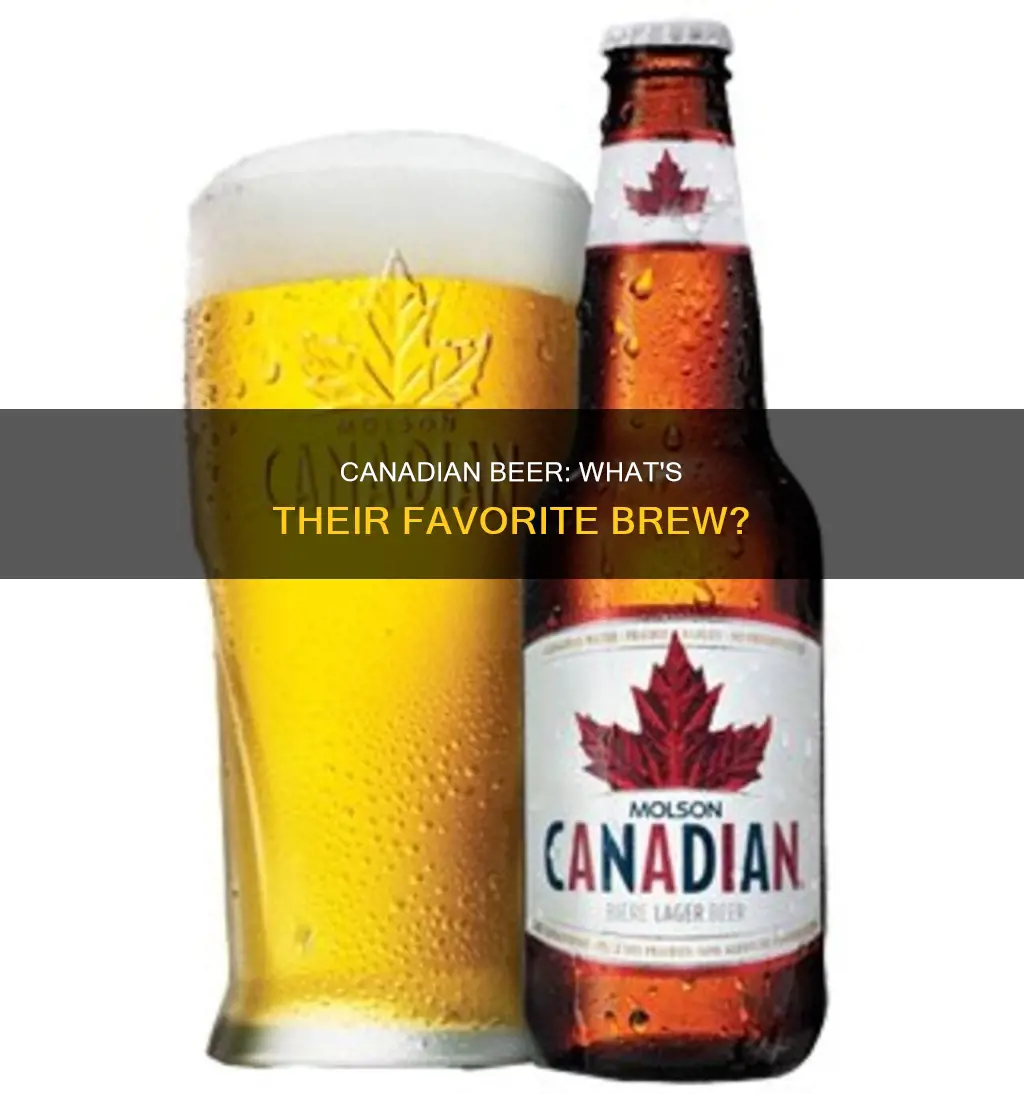
Beer is a significant part of Canadian culture and is the country's most popular alcoholic beverage. The beer industry plays an important role in Canadian identity, and beer is consumed at most social events and gatherings. While the country's beer industry has seen a lot of consolidation and foreign ownership, with major players like Labatt, Molson, and Sleeman being acquired by or merged with foreign companies, there is also a thriving craft beer scene, with microbreweries and small operations springing up across the country.
Some of the most popular beer brands in Canada include Molson Canadian, Labatt Blue, Budweiser, Coors Light, and Molson Export. These beers are often the cheapest options and are widely consumed, especially by students and those on a budget. However, there are also many regional and local beers that are gaining popularity, and microbreweries are making a comeback.
Canada has a diverse range of beer styles, from pale lagers to brown ales, porters, and IPAs. The country also has some unique beer styles, such as spruce beer, which was first brewed in the 16th century to prevent scurvy, and ice beer, which is based on the German Eisbock style.
What You'll Learn

Popular Canadian beer brands
Beer is a significant part of Canadian culture, with the country's beer industry playing an important role in Canadian identity. Beer is the most popular alcoholic beverage in Canada, and the country's beer culture dates back generations.
The most popular Canadian beers include:
- Molson Canadian (Canada's largest by overall sales)
- Labatt Blue
- Moosehead Lager (Canada's oldest independent brewery)
- Sleeman
- Kokanee
- Alexander Keith's IPA
- Unibroue's La Fin du Monde
- Sleeman's Honey Brown
- Dieu du Peche Mortel
- Big Rock Traditional Ale
- Mill Street Tankhouse Ale
- Unibroue Trois Pistoles
While these are some of the most popular beers in Canada, the country is also home to many microbreweries and craft beers, which have been increasing in popularity in recent years.
Beer After a Workout: Good or Bad Idea?
You may want to see also

The history of beer in Canada
Canada's love affair with beer is well-known and the drink is considered a part of the nation's identity and heritage. Beer was introduced to the country by European settlers in the seventeenth century, with Canada's first commercial brewery, La Brasseries du Roy, established in Quebec City in 1668 by New France Intendant Jean Talon. Canada's cold climate was ideal for brewing before refrigeration, and the industry thrived in the new country.
The industry thrived until the late nineteenth century when the Canadian government attempted to eliminate "intoxicating" beverages, leading to the closure of many breweries. This continued into the twentieth century with the introduction of Prohibition in 1918, which lasted until 1920. Despite these setbacks, the industry recovered and by the 1980s, craft breweries began to emerge and gain popularity.
Early History
Beer was first introduced to Canada by European settlers in the seventeenth century. The country's first commercial brewery, La Brasseries du Roy, was established in Quebec City in 1668 by New France Intendant Jean Talon. Canada's cold climate was ideal for brewing before refrigeration, and the industry thrived in the new country.
Prohibition
In the late nineteenth century, the Canadian government began to crack down on "intoxicating" beverages, leading to the closure of nearly three-quarters of breweries between 1878 and 1928. This continued into the twentieth century with the introduction of Prohibition in 1918, which lasted until 1920. During this time, many breweries coped by producing "temperance brews" with a maximum alcohol content of 2.5%, diversifying into soft drinks, or engaging in bootlegging. The latter was made possible by a loophole in the Prohibition laws, which allowed for the production and export of alcoholic beverages, even while their sale within Canada was prohibited.
Post-Prohibition
After Prohibition ended, the sale of alcoholic beverages remained heavily controlled by government liquor boards and publicly-owned stores. The controls led to the growth of "beer parlours" or "taverns", which had no bar and did not serve meals. These establishments became a factor in making beer a national drink of Canada.
A period of consolidation followed, with the industry becoming extremely concentrated in the hands of just three companies: Canadian Breweries, Molson, and Labatt. These companies bought out or merged with dozens of smaller breweries.
Rise of Craft Breweries
Despite the dominance of these large companies, the Canadian beer industry began to change in the 1980s with the emergence of craft breweries. The revival of craft brewing is attributed to various factors, including the creation of organisations promoting better-quality beer and the deregulation of beer prices. Horseshoe Bay Brewery, which opened in West Vancouver in 1982, is considered one of Canada's first microbreweries.
The number of licensed breweries in Canada has increased significantly in recent years, growing from 310 in 2010 to 640 in 2015. The production of beer by microbreweries, or "craft brewing", is a fast-growing segment, appealing to a wider demographic than traditional mass-market beers.
Monks and Their Daily Beer Consumption
You may want to see also

Beer in Canadian culture
Beer is a significant aspect of Canadian culture, with the country's beer industry playing an important role in Canadian identity. Beer was introduced to Canada by European settlers in the seventeenth century, and the country's cold climate was considered ideal for brewing before refrigeration. Canada's first commercial brewery was built and opened in Montreal, Quebec, in 1650, and since then, beer drinking has become a prominent part of Canadian culture.
In Canadian culture, beer is often consumed during social events, gatherings, and get-togethers, with many traditions involving drinking local beers. For example, grabbing a beer while watching hockey or cheering on a favourite sports team is a common pastime for Canadians. The country's long history of beer drinking dates back generations and has evolved over time, with traditional brewing methods being integrated with modern techniques.
When it comes to popular beer choices, Canadians have a variety of options. The country is home to numerous breweries, ranging from large, well-known companies to small, local microbreweries. Some of the most popular Canadian beer brands include Molson, Labatt, Sleeman, and Moosehead. These brands offer a range of beers, from pale lagers to ales, and have become staples in the Canadian beer industry.
In addition to the major beer brands, the growth of microbreweries and craft brewing has provided Canadians with even more options for locally brewed beers. This segment of the industry is experiencing rapid growth, appealing to a wider demographic than traditional mass-market beers. The variety of beers available in Canada, from light and refreshing to full-bodied and flavourful, ensures that Canadians can find a beer to suit their taste preferences and occasions.
Overall, beer is deeply ingrained in Canadian culture, and the country's beer industry continues to evolve and thrive, reflecting the history and diversity of the nation.
Beer for Breakfast: Why Do People Do It?
You may want to see also

Beer sales in Canada
Beer is a significant part of Canadian culture, with the country's beer industry playing an important role in Canadian identity. Beer is the most popular alcoholic beverage in Canada, and its consumption is deeply ingrained in the country's traditions and social events.
History of Beer in Canada
Canada was introduced to beer in the 17th century by European settlers, who brought their brewing traditions to the country. The first commercial brewery, La Brasseries du Roy, was established in Quebec City in 1668. However, the preferred drink among citizens at the time was imported wine or brandy. The early history of beer in Canada also included the development of spruce beer, both alcoholic and non-alcoholic, which was initially used to prevent scurvy.
While beer holds cultural importance in Canada, sales have been sluggish in terms of volume and industry revenue growth due to the rising popularity of other beverages, particularly wine. The Canadian beer market has also been impacted by the acquisition of major Canadian beer producers by foreign companies, with the largest beer producers—Labatt, Molson, and Sleeman—now under foreign ownership. Despite this, the number of licensed breweries in Canada has increased significantly, growing from 310 in 2010 to 640 in 2015. This growth is largely driven by the proliferation of small, local microbreweries that produce craft beer, which has become increasingly popular among Canadians.
The overall volume of beer sold in Canada increased only minimally in the previous decade, with domestic beer contributing to a 1.1% increase. Imports made up the remaining 0.6% increase, highlighting the growing popularity of imported beer in the Canadian market. While beer remains the most popular alcoholic beverage, its market share in dollar value has decreased due to the rise of wine.
Popular Beer Brands in Canada
Some of the most popular beer brands in Canada include Molson, Labatt, and Sleeman, which are widely available across the country. Molson Canadian and Labatt Blue have traditionally been the top-selling brands and are considered the two prominent companies in the Canadian beer market. However, in recent years, they have faced increasing competition from other brands, including Budweiser, Coors Light, and Alexander Keith's. The rise of microbreweries and craft beers has also diversified the beer landscape in Canada, with many consumers embracing locally brewed options.
Beer and Liquor Mixing: Safe or Not?
You may want to see also

Beer styles in Canada
Beer is a significant part of Canadian culture, with the country's beer industry playing an important role in Canadian identity. Beer is the most popular alcoholic drink in Canada, and there are several styles to choose from.
Spruce Beer
Spruce beer is one of the oldest and most popular beer styles in Canada. It originated in the 16th century as a way to prevent scurvy. Both alcoholic and non-alcoholic versions of spruce beer are available across the country, and it is considered an authentic Canadian beer style. Spruce beer is made with spruce tips, no malt, and flavourings such as brown sugar or maple syrup.
Ice Beer
Ice beer is another Canadian original, though it is based on the German Eisbock style of beer. To create ice beer, the temperature of a batch of beer is lowered until ice crystals form, resulting in a higher alcohol-to-water ratio.
Cream Ale
Cream ale is one of the most popular Canadian beer styles. It started as an offshoot of light lager, and the combination of warm fermentation and cool storage gives it a unique and delicious flavour. Cream ale has a crisp taste and complex aromas, making it a favourite among Canadians.
Pale Lager
The top-selling style of beer in Canada is the pale lager, also known as the North American Style Lager. Budweiser was the best-selling brand in 2016, and many of its products are manufactured in Canada.
Brown Ale
Brown ale is another popular style, with Muskoka Brewery's Harvest Ale being a recommended choice.
Porter
For porter lovers, Clifford Brewing's craft beer is a delicious option.
Pale Ale
Steam Whistle Pale Ale, from Ontario, is a popular choice in this style.
Lager
Popular lager options include Moosehead, Molson, and Labatt Blue.
Microbreweries and Craft Beers
The craft beer scene in Canada has grown significantly, leading to an increase in the number of beer styles available. Microbreweries and craft beers are becoming increasingly popular, especially among those seeking a wider range of flavours beyond the traditional mass-market beers.
Beer and Yeast Infections: Is There a Link?
You may want to see also
Frequently asked questions
Popular Canadian beer brands include Molson, Labatt, Sleeman, Moosehead, Kokanee, and Big Rock Brewery.
Popular styles of Canadian beer include pale lager, North American Style Lager, cream ale, and ice beer.
In Quebec and the Maritimes, lager-like ales such as Molson Export and Alexander Keith's are popular. In Ontario, the most popular types are pale lagers like Molson Canadian and Labatt Blue. In British Columbia, craft beer has seen major growth, with Victoria and Vancouver being the two most dense areas for breweries.
Beer was introduced to Canada by European settlers in the 17th century, and the country's first commercial brewery was established in the 1650s. Beer has played an important role in Canadian culture and social gatherings, and the country has a long tradition of beer-making.







